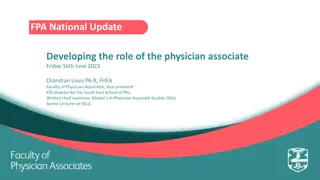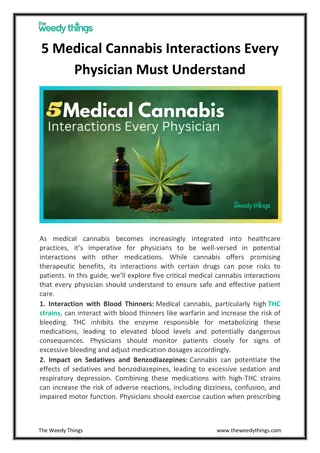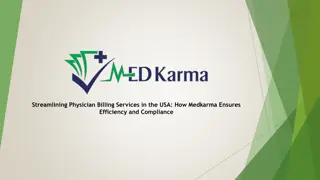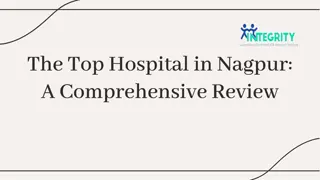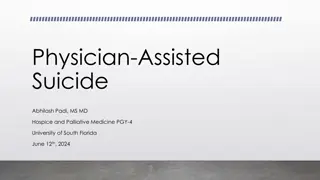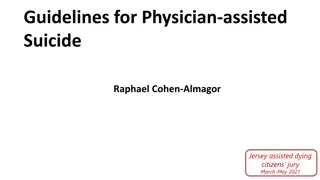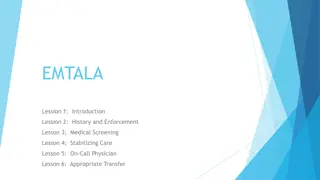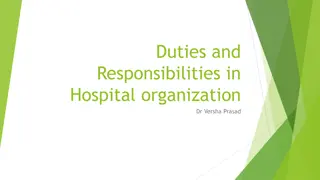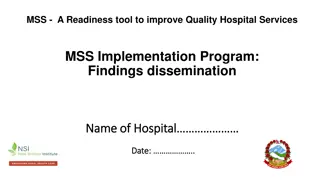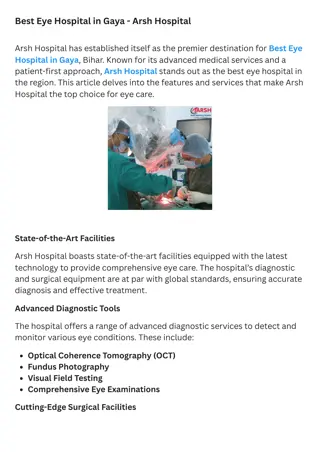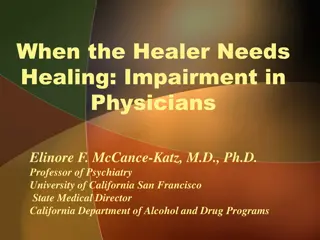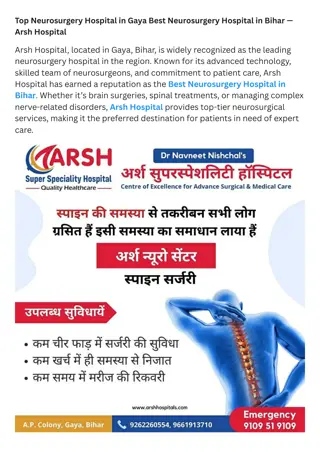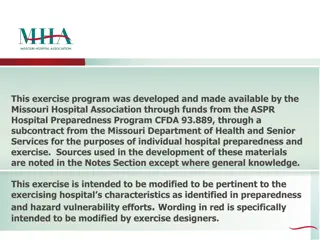Understanding EMTALA: Hospital and On-Call Physician Responsibilities
EMTALA, the Emergency Medical Treatment and Labor Act, mandates that hospital emergency departments assess and stabilize all patients seeking care, regardless of insurance or ability to pay. On-call physicians serving the Emergency Department have specific responsibilities outlined in this guidance. The law aims to ensure timely and necessary medical attention for individuals in need, emphasizing the importance of stabilization and proper treatment. Enforcement bodies like CMS, OIG, and QIO oversee EMTALA compliance, with state survey agencies playing a crucial role. Learn more about EMTALA's definitions, enforcement bodies, and the significance of this federal law in healthcare.
- EMTALA
- Emergency Medical Treatment
- Hospital Responsibilities
- On-Call Physician
- Healthcare Compliance
Download Presentation

Please find below an Image/Link to download the presentation.
The content on the website is provided AS IS for your information and personal use only. It may not be sold, licensed, or shared on other websites without obtaining consent from the author. Download presentation by click this link. If you encounter any issues during the download, it is possible that the publisher has removed the file from their server.
E N D
Presentation Transcript
EMTALA Hospital and On-Call Physician Responsibilities HonorHealth Compliance Department 2017
EMTALA Hospital and On-Call Physician Responsibilities On-call physicians serving the Emergency Department have certain responsibilities under the Emergency Medical Treatment and Active Labor Act or EMTALA. This presentation is intended as a guide for your understanding and clarification. EMTALA is the hospital s on-call policy. This guidance is not intended as all encompassing or as a comprehensive discussion of EMTALA. Please refer to other references including the EMTALA statutes, relevant Center for Medicare and Medicaid Service (CMS), and the Medicare Hospital Conditions of Participation (CoP s) Also, please contact the Compliance Office at 480-882-4971 for further assistance.
Definitions Emergency Medical Condition (EMC): A medical condition manifesting itself by acute symptoms of sufficient severity (including severe pain) such that the absence of immediate medical attention could reasonably be expected to result in: Placing the health of the individual (or with respect to a pregnant woman, the health of the woman or her unborn child) in serious jeopardy Serious impairment to bodily functions Serious dysfunction of any bodily organ or part Stabilization: To provide such medical treatment of the condition as may be necessary to assure, within reasonable medical probability, that no material deterioration of the condition is likely to result from or occur during the transfer of the individual from a facility, or, with respect to a pregnancy woman, to deliver (including the placenta).
Enforcement Bodies Center for Medicare and Medicaid Services (CMS) www.cms.hhs.gov/EMTALA Office of Inspector General (OIG) Quality Improvement Organization (QIO) Livanta for HonorHealth State survey agencies, specifically the Arizona Department of Health and Human Service
What is EMTALA? EMTALA (Emergency Medical Treatment and Labor Act) is a federal law that requires hospital emergency departments to medically screen every patient who seeks emergency care and to stabilize or transfer those with medical emergencies, regardless of health insurance status or ability to pay. This law has been an unfunded mandate since it was enacted in 1986. Emergency departments are under severe stress, facing soaring demands. Many have closed because of uncompensated care due in part to the unfunded EMTALA mandate.
What are the responsibilities of hospitals and physicians under EMTALA? A physician or other qualified medical personnel must provide an appropriate medical screening exam to individuals who enter the dedicated emergency department for a medical condition, or who are on hospital property and experience a medical condition, to determine the presence or absence of an emergency medical condition. To stabilize the medical condition of the individual if an emergency medical condition is found, within the capabilities of the staff and facilities available at the hospital, prior to discharge or transfer. Obstetric patients with contractions are considered unstable until delivery of baby and placenta.
Hospital and Physician Responsibilities (continued) An unstable patient cannot be transferred unless the patient (of a person acting on his or her behalf) requests the transfer or the transferring physician certifies in writing that the medical benefits of the transfer outweigh the risks, and is in the best medical interest of the patient.
What treatment and services must be provided to be in compliance with EMTALA? On-call physicians must respond to the hospital when requested to attend to patients in a timely manner and complete a medical screening exam or provide stabilizing care unless circumstances beyond the physician s control prevent a response. The transferring physician must discuss the case with the receiving hospital s authorized representative and obtain agreement to accept the patient in transfer. When a receiving hospital has the necessary on-call physician , the hospital is considered to have specialized capabilities and may not refuse a patient s transfer, absent a lack of capacity. This means that the on-call physician is on-call not just for his/her hospital but for the entire state and country.
Transfer Responsibilities: Hospital Stabilize the patient within the hospital s capabilities to minimize the risk of transfer. Obtain the acceptance of the receiving hospital. Provide all pertinent medical records available at the time of the transfer to the receiving hospital. Affect the transfer through qualified persons and transport equipment (including life support measures).
Transfer Responsibilities: Hospital and On-Call Physician A receiving hospital, with specialized capabilities (which includes on-call specialists), must accept a patient transfer if it has the capability and capacity (beds) for providing care. CMS does not have a specific requirement regarding how frequently physicians have to be on call. The only requirement is that the hospital provide enough call for safe and effective patient care. OIG clarified in 2017 that the on-call physicians at any participating hospital are subject to EMTALA including sanctions for violations.
Transfer Responsibilities: Hospital and On-Call Physician (continued) On-call physicians who fail to appear within a reasonable amount of time or refuse to show up are subject to EMTALA enforcement. Enforcement includes civil monetary penalties and possible exclusion from Medicare and Medicaid participation.
On-Call Physician Responsibilities Physicians who are on call are not representing their office practice. They are representing the hospital. Physician having an office full of patients is no excuse to now showing up when on-call and requested by the ED doctor to see the patient. It is inappropriate if a surgeon on call can not respond because he had eight hours of elective surgery scheduled. It is generally not acceptable to send ED patients to their offices for exam and treatment of an emergency medical condition.
On-Call Physician Responsibilities Exception is made when medically indicated and patient needs specialized service like special equipment the hospital does not have. The on-call physician must respond whether or not the patient belongs to a Managed Care Organization in which the physician participates, is a Medicaid or Medicare patient, or whether the patient has no insurance. Medical Staff Rules and Regs require that the on-call physician accept referrals to their office for at least one visit following discharge from the ED.
Which Medical Staff documents define the responsibilities of an on-call physician? The Medical Staff bylaws, rules and regulations, define the responsibility of on- call physicians to respond, accept, examine and treat patients with emergency medical conditions. Each Medical Staff Department is responsible for establishing its Emergency Department call requirements. On-call physicians who, as part of their routine responsibilities, are charged with the duty to accept patients transferred from other facilities, may not refuse any unstable transfer as long as their hospital has the capability and capacity to provide treatment. Scottsdale Healthcare Medical Staff Rules and Regulations require that the on- call physician respond within 20 minutes of being called. The on-call physician must present to the ED within 30 minutes when requested by the ED physician. Deer Valley and Lincoln Medical Staff Rules and Regulations require that the on-call physician be available and accessible by phone and respond to all calls. The on-call must respond in person if requested to come in by the Emergency Department physician.
What are the penalties or sanctions for EMTALA violation? Medicare participating hospitals and physicians found to be in violation of EMTALA could be sanctioned as follows: Termination of the hospital and/or physician from the Medicare program Imposition of civil monetary penalties against the hospital and/or physician of $104,826 per violation (effective February 2017).
What if an on-call physician refuses or fails to show up or answer when called? The physician s name and address will be included in the medical record and he or she may be subject to sanctions.
Where On-Call Physicians Get Into Trouble Instead of responding to a request by the ED physician to come to the hospital the on-call physician tells the ED physician to admit and he will see the patient later. Problem: EMTALA requires a reasonable response time. HonorHealth Rules and Regulations allows 30 minutes (or reasonable time) to come in when asked by the ED physician.
Where On-Call Physicians Get Into Trouble When asked to come to the ED to see a patient physician debates the necessity of coming in. Or, when asked to come in refuses and orders patient sent to another facility. Problem: Response is not negotiable or debatable.
Where On-Call Physicians Get Into Trouble When asked to come to the ED physician declines saying patient needs exceeds their scope of practice. Problem: Physician must render care within their Medical Staff privileges and not their usual scope of practice. If reported surveyors will check Medical Staff privileges.
Where On-Call Physicians Get Into Trouble On-call physician refuses to accept a transfer stating that he/she is saturated Problem: The only reason to legitimately refuse a patient transfer is if the hospital is clearly not able to provide the necessary care (i.e., no ICU beds, or the physician is truly involved in another emergency situation that will prohibit providing care). Otherwise, if the services are available they must be made available to any patients who need them.
Where On-Call Physicians Get Into Trouble When responding to a request to accept a transfer, on-call physician refuses stating that there are other closer hospitals that should be called instead, or that the transferring hospital is too far away. Problem: Although it is best for the patient to travel the shortest distance for care there is no EMTALA rule stating that the closest facility must be contacted for transfer.
Inappropriate Responses with Possible Sanctions When asked to come to the ED physician refuses stating that patient was previously discharged from their practice for non compliance or non payment. When asked to come to the ED the on-call physician responds not interested because patient is aligned with another physician who is unavailable or declined to come in. On-call physician refused to accept a patient because a specialist at the first hospital was not available.
Questions? Please contact the Compliance Office at 480-882-4971



